Disinfection of ventilation systems: the need for and
In this article we will talk about what a disinfection of the ventilation system is about, how it can be triggered and what methods it is used with.
The duct system, as well as other elements in the composition of the ventilation, is in contact with the unpurified air, and therefore during operation a large amount of animal hair, dust, soot, etc. accumulates in it. In order to decide why disinfection of air ducts of ventilation systems is necessary, it is necessary to understand the consequences of such contamination.
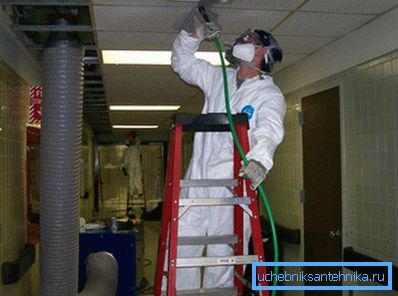
The presence of organic pollutants is a favorable environment for the development and reproduction of a wide range of harmful microorganisms, including mites, bacteria and mold. The vital activity of these microorganisms adversely affects the quality of air entering the room from the intake ventilation or from the air-conditioning system.
Such developments can be avoided by regularly conducting a complete disinfection of the ventilation system as a whole or of its components separately.
The need for properly performed disinfection of air ducts on an industrial scale
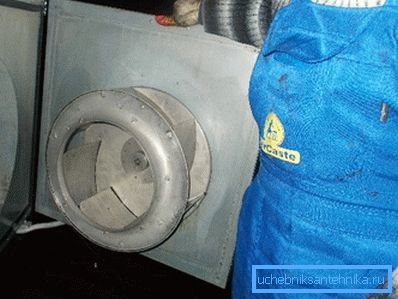
Not so long ago, the pollution of the ventilation duct became the reason for replacing the entire system, which in turn cost a considerable amount of money.
Currently, an effective and, most importantly, quick cleaning, carried out with the use of modern technologies, allows to solve the problem with minimal waste. Moreover, some technologies allow the disinfection of air ducts without interrupting the operation of the building, which is especially important from the point of view of using industrial facilities.
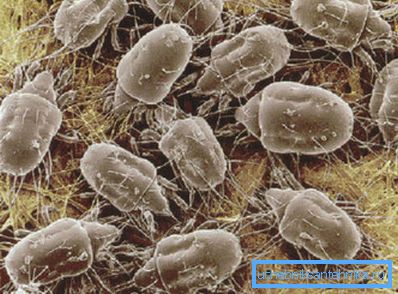
So, let's try to determine what caused the need for disinfection:
- Health care is probably the most important reason for the timely disinfection of ventilation equipment.. At the initial stages of cleaning work, control tests are collected in order to determine the content of pathogens. Disinfection of ventilation and air conditioning systems is considered mandatory if the results of the tests show bacteria such as Staphylococcus aureus, Koch's wand (the cause of tuberculosis), food fungi, mold spores and some fungal infections. Of course, the effective destruction of the previously listed microorganisms is a significant contribution to the improvement of the people inhabiting this or that object or staying in the building on duty.
- Protecting people from the threat of allergic reactions is a continuation of the previous topic.. But the fight against pathogens of allergy is no less important than the need to eliminate the previously listed pathogens. It has been empirically established that allergic reactions in production personnel are most often caused by bacteria that accumulate in contaminated ventilation systems. That is why professionally conducted cleaning of ventilation is not a whim or excess, but an obvious necessity.
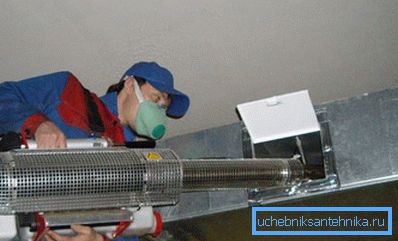
- Ensuring the flow of snow air into the room is another reason for the ventilation and air conditioning systems to be cleaned in a timely manner.. With a significant contamination of the duct into the room penetrates the air with the smell of rot or mold. Of course, such smells create an atmosphere of discomfort. Therefore, if contamination is established, disinfection should be proceeded without delay.
- Compliance with fire safety regulations also requires keeping the interior of the ventilation systems clean.. The fact is that air duct contamination poses a significant fire hazard. Flakes of dust and grease deposited in the pipes can flare up from a spark of a static charge or from a cigarette butt thrown into the ventilation.
- Compliance with and compliance with the norms of the sanitary legislation of the Russian Federation is also a reason for the immediate implementation of cleaning measures.. The fact is that a contaminated ventilation system in production or in office buildings can be a reason for penalties that will adversely affect the enterprise’s budget.
So, after we are convinced of the need for decontamination of the supply and exhaust channels, consider the features of the implementation process.
The main stages of industrial disinfection and methods for their implementation

Professional or self-cleaning and disinfection of ventilation systems is a combination of comprehensive measures aimed at the effective destruction of pathogens and the improvement of indoor air quality.
Instructions for disinfection of supply and exhaust channels are as follows:
- At the initial stage, the state of the air ducts is assessed. A preliminary visual inspection of the equipment is carried out, and then the washes are taken from its inner surface. Next, the washings are sent to laboratory tests, where, based on the tests performed, the degree of contamination of the system is determined and a decision is made about the need for decontamination. Also at this stage, you can make an objective decision on the choice of method of cleaning and on the feasibility of the selection of an antibacterial drug.
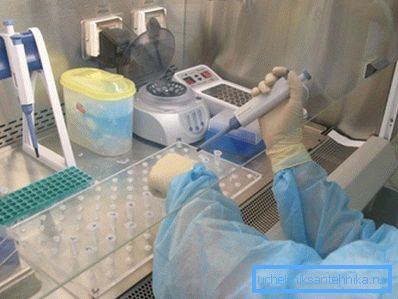
- At the next stage, the price of cleaning and disinfecting works will be determined. Cost calculations are based on previously studied analyzes. Also at this stage it is possible to make a decision on the choice of one or another method of carrying out cleaning works in accordance with the budget allocated for the operation and maintenance of the system as a whole.
- Cleaning air ducts, in turn, can be carried out in two ways:
- Mechanical cleaning of ventilation, implemented with the use of high-power industrial vacuum cleaners or a brush machine. Another method used in the framework of this method is blowing out ventilation with compressed air, which takes out much of the pollution.
- Cleaning with the use of special chemical reagents that make up the specialized preparations approved for use in buildings of residential, public and industrial use.
- Upon completion of activities aimed at decontamination and cleaning, an assessment of the quality of the work done and the result obtained is carried out. After the cleaning is done, the tests are taken, which are then sent to the laboratory, where the presence of potentially dangerous microorganisms is detected. Also at this stage a decision is made about the need for subsequent cleaning.
- Documentation of implemented cleaning measures (stage, relevant only in case of ordering services in specialized organizations). The compiled documentation is a description of the methods and preparations used during the work done. Again, these documents are attached to the results of the initial and final laboratory tests of analyzes taken from the ducts.
The need to clean household ventilation systems
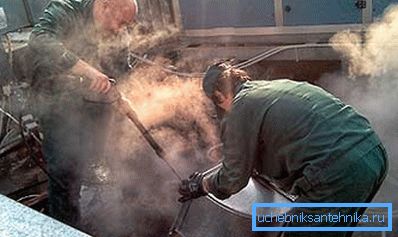
What are the consequences of contamination of household ventilation and why should you take special responsibility to carry out work on cleaning and disinfecting such equipment?
Immediately, we note that the cleaning and disinfection of ventilation and air conditioning systems at home is no less important and necessary than similar work carried out on an industrial scale. After all, it is no secret to anyone that at home we spend about one third of our lives, and therefore it is simply necessary to take care of the proper comfort of living conditions.
Currently, most of the new construction sites are necessarily equipped with centralized ventilation or air conditioners installed in residential premises. Like any other equipment, ventilation systems need regular maintenance.
Irregular conduct of this service will negatively affect not only your life comfort, but also the performance of the climate equipment. After all, clogged air ducts are a significant obstacle to the transportation of air. As a result, the performance of the channels is reduced and they, in one way or another, require cleaning.
Important: The blockages of household ventilation of pathogenic microorganisms are contained in no less than in industrial air ducts. But when you consider that the area of residential premises is an order of magnitude smaller than the area of premises in public or industrial buildings, the damage to our health in the event of pollution of household ventilation will be more noticeable.
So, disinfection of air conditioning and ventilation systems in everyday life is necessary, it remains to figure out how to cope with this difficult task with your own hands using available means?
Cleaning household ventilation
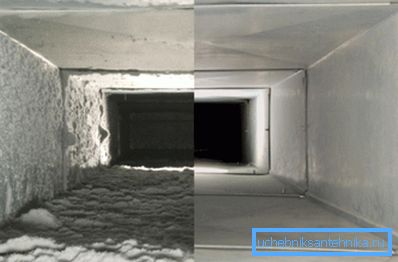
The main problem in the operation and maintenance of domestic air conditioning systems is dust, which is not as easy to deal with as it may initially seem.
Before embarking on cleaning work, we will determine what we will have to fight. Dust is an aerosol with an air-dispersed composition consisting of different-sized particles in a suspended state.
In accordance with the requirements of sanitary standards, the degree of dust concentration per cubic meter of the volume of premises should not exceed 0.15 mg. In fact, the situation in most residential premises does not meet these standards and the permissible level is substantially exceeded.
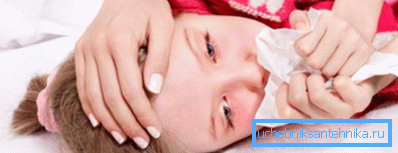
It is enough to remove the grate from the vent, and you will surely see dust that does not lie in a thin layer, but literally hangs down in tatters.
If you collect these rags and send them to the laboratory in the dust will be detected:
- dust mites, saprophytes;
- microscopic mite feces;
- various allergens;
- wide range of decomposers.
Of course, with all this infection, we breathe for at least one third of our lives, and this negatively affects our health and everyday well-being.
The only way out in this difficult situation is to clean all the instruments and devices through which air flows from outside to the room.
A / C service
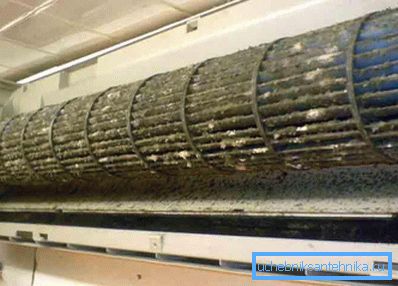
To clean a household split system, you must remove the front cover on the indoor unit and remove the filter screen.
The regularity of the procedure depends on the time of year. For example, in the summer, the cleaning of the indoor unit is carried out monthly, and throughout the winter this work can be done once.
The screen and filters are cleaned with a vacuum cleaner and installed in the device in the reverse order. In order to avoid breakdowns when removing and installing filters, you need to follow the instructions of the user.
The external unit of the air conditioner is also cleaned of dust. To do this, use a powerful vacuum cleaner with a fleecy nozzle. Vacuuming the surface of the external unit, namely, that part of it, where the radiator is located.
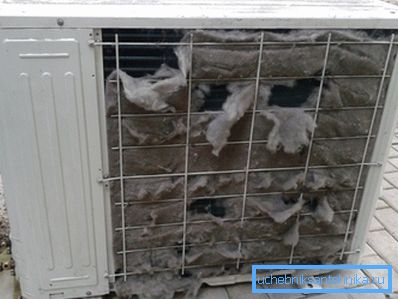
Important: The design of the external unit is not resistant to mechanical loads, and therefore, try not to press the vacuum cleaner on the radiator, so as not to leave any dents on it.
Household ventilation service
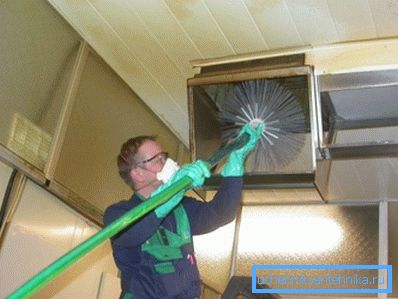
Cleaning domestic ventilation systems is carried out in two ways:
- Dry cleaning is the easiest and most affordable method. During the work, the device is used structurally similar to the brush used to clean the chimneys. The device is inserted into the outlet and pushed deep into the channel. After the dust from the walls of the duct is removed, it must be removed and for this purpose an industrial vacuum cleaner or a mobile filtration unit (PFC) is used.
- Mechanical cleaning is used in cases where the pollution is formed not only by the accumulation of dust, but also by fatty deposits. As a rule, such works are performed in kitchens, where a large amount of soot penetrates the hood, which the brush attached to the flexible shaft cannot be removed. During mechanical cleaning, the hood and vents that can be removed are removed. Further, special brushes remove soot from straight pipe sections. In case of especially heavy pollution, mechanical cleaning of air ducts is used in combination with the use of chemical reagents for splitting fats.
Conclusion
Now that we have a general idea of what disinfection of ventilation systems and air conditioning systems are, we can try to put this information into practice and make the air in our home cleaner. You will find more useful information by watching the video in this article.